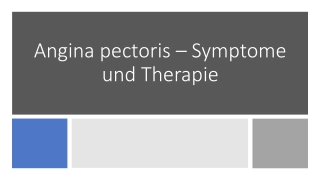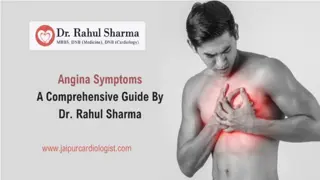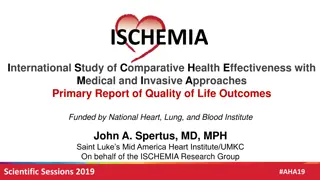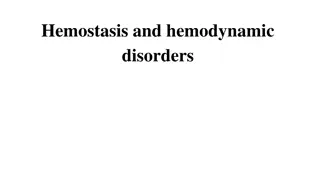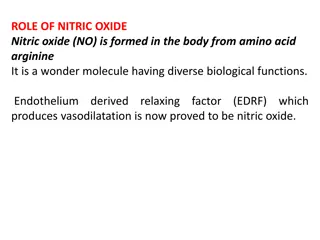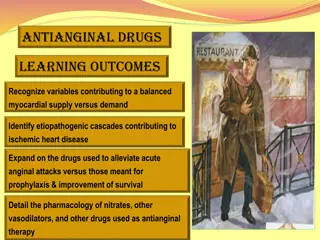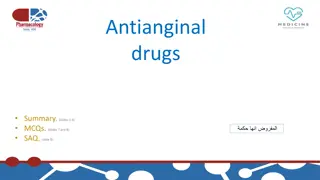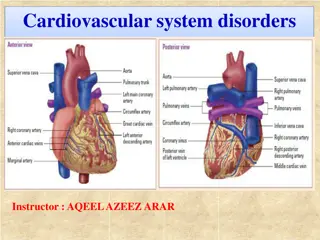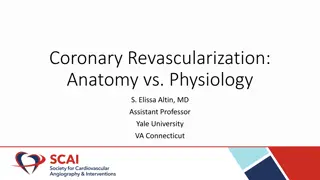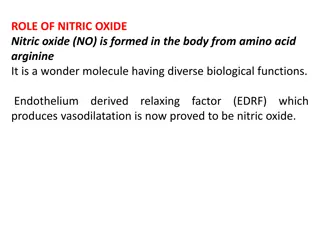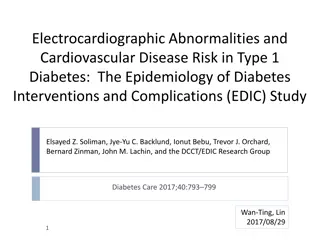Angina Pectoris: Symptoms and Therapy
The symptoms and treatment of angina pectoris, a condition characterized by chest pain and discomfort. Discover effective therapies and how to manage symptoms.
1 views • 9 slides
Understanding Coronary Artery Bypass Graft (CABG) in Adult Nursing
Coronary Artery Bypass Graft (CABG) is a surgical procedure where a blood vessel from another part of the body is grafted onto an occluded coronary artery to bypass blockages. This procedure is less common in women compared to men and is typically indicated for severe coronary artery disease. It is
5 views • 15 slides
Cardiologist In Jaipur-Dr Rahul Sharma
Angina Symptoms: Angina is a condition characterized by chest pain or discomfort caused by reduced blood flow to the heart muscle. It\u2019s often a symptom of underlying coronary artery disease, which occurs when the arteries that supply blood to the heart become narrowed or blocked by plaque build
1 views • 6 slides
Comparative Health Effectiveness Study: Quality of Life Outcomes with Medical and Invasive Approaches
This primary report funded by the National Heart, Lung, and Blood Institute presents the International Study of Comparative Health Effectiveness with Medical and Invasive Approaches. The research evaluates whether an invasive strategy improves health status in stable patients with moderate ischemia,
1 views • 21 slides
Understanding Hemostasis and Hemodynamic Disorders in Health
Hemostasis is crucial for maintaining the health of cells and tissues by ensuring continuous circulation of water, oxygen, and nutrients while removing metabolic waste products. Factors controlling normal hemostasis include the integrity of blood vessel walls, blood content, platelet function, and l
0 views • 14 slides
Role of Nitric Oxide in the Body: Functions, Formation, and Clinical Aspects
Nitric oxide (NO), a vital molecule formed from arginine, plays diverse roles in the body including vasodilation, neurotransmission, platelet regulation, and immune response. Its formation involves a complex enzyme called nitrogen oxide synthase. Various inhibitors and clinical implications, such as
0 views • 19 slides
Understanding Chronic Coronary Syndrome: Causes, Symptoms, and Management
Chronic coronary syndrome involves a dynamic process of atherosclerotic plaque accumulation and functional alterations in coronary circulation. It includes various clinical scenarios such as stable angina, asymptomatic ischemia, prior myocardial infarction, and more. The condition can be modified by
0 views • 131 slides
Understanding Antianginal Drugs and Treatment Options
Recognize the variables contributing to balanced myocardial supply and demand, identify etiopathogenic cascades in ischemic heart disease, and learn about drugs for acute angina relief and prophylaxis. Delve into the pharmacology of nitrates, vasodilators, and other antianginal therapies. Explore th
2 views • 18 slides
Understanding Antianginal Drugs: Mechanisms, Classification, and Usage
Signs, symptoms, and types of angina pectoris are explored, along with the determinants of oxygen demand and supply. Treatment options, including organic nitrates like isosorbide mononitrate and nitroglycerine, are detailed, highlighting their mechanisms of action, hemodynamic effects, adverse react
2 views • 10 slides
Understanding Acute Coronary Syndromes: Causes, Symptoms, and Risk Factors
Acute coronary syndromes (ACS) encompass a spectrum of conditions such as unstable angina, non-ST-segment elevated MI (NSTEMI), and ST-segment elevated MI (STEMI) that result from coronary artery occlusion. Risk factors for ACS include family history of heart disease, obesity, smoking, and hypertens
0 views • 20 slides
Vascular Team Approach in Unstable Angina with Complex Vascular Disease
A 73-year-old patient with COPD, hypertension, and hyperlipidemia presents with severe lower extremity ischemia, leading to a plan for urgent aorto-bifemoral bypass. The clinical examination and test results revealed critical limb ischemia and extensive vascular disease requiring intervention from c
0 views • 19 slides
Understanding Coronary Revascularization: Anatomy vs. Physiology
This content discusses the prevalence of angina in women compared to men, the importance of stable angina in predicting outcomes, the need for better diagnostic methods for coronary angiography, and the differences in obstructive CAD by sex and ethnicity in stable angina cases. It highlights the cha
0 views • 22 slides
Role of Nitric Oxide in Biological Functions and Health
Nitric oxide (NO), a vital molecule formed in the body from arginine, plays diverse roles such as vasodilation, neurotransmission, platelet inhibition, and immune response mediation. It is essential for regulating blood flow, maintaining blood pressure, and muscle relaxation. Various inhibitors impa
0 views • 26 slides
Electrocardiographic Abnormalities and Cardiovascular Disease Risk in Type 1 Diabetes
This study examines the association between ECG abnormalities and incident CVD events in patients with type 1 diabetes, focusing on the prognostic significance in a population where CVD develops earlier. Major and minor ECG abnormalities were classified, with cardiovascular events such as myocardial
0 views • 16 slides
Understanding Newer Antianginals and Cardiomyocyte Metabolism
Chronic angina is a condition marked by impaired quality of life and decreased life expectancy, primarily due to myocardial ischemia. It is characterized by symptoms like tightness, heaviness, and pressure sensation, often located retrosternally. The pathophysiology involves a mismatch between oxyge
0 views • 73 slides
